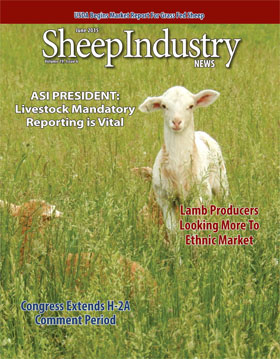
- June 2015
- President’s Notes
- Congress Extends H-2A Period
- Theos Family Reaching Niche Lamb Market
- Market Report
- Australian Wool Market Rallied; U.S. Gains
- USDA Begins Releasing Grass Fed Report
- Clark Willis Obituary
- Region IV Bighorn Plan Implemented in Utah
- Western Lawmakers Team to De-List Wolves
- ASI Photo Contest
- ASI Supports COOL For Lamb
- Battle Not Over in Sage Grouse Fight
- Livestock Mandatory Reporting
- No Grazing This Summer
- Separate Efforts: Scrapie Eradication Program and the Animal Disease Traceability Program
- Lamb Producers Look to Ethnic Groups
- Study Explores Disease in Grand Canyon Bighorns
- Sheep News In Brief
No Grazing This summer
University of Idaho Won’t Put Sheep on U.S. Sheep Experiment Station Acres
By Keith Ridler, Idaho Statesman
The University of Idaho won’t graze sheep this summer on three high-elevation areas in eastern Idaho and western Montana until a lawsuit filed by environmental groups concerning a federal sheep research facility is resolved.
Federal officials in documents filed in early May in U.S. District Court said the university in March notified the U.S. Department of Agriculture by email that it wouldn’t send sheep or sheepherders to grazing areas used by the U.S. Sheep Experiment Station near Dubois in eastern Idaho.
The school in the email said it sees value in research to assist the sheep and cattle industry, as well as research on rangeland ecosystems and wildlife populations. But the school also said “this research must be conducted in a manner consistent with applicable law.” The lawsuit filed in 2014 contends that the sheep station didn’t follow federal environmental laws to determine the impacts of sheep grazing on grizzly bears, lynx, wolves, bighorn sheep and other animals.
The environmental groups say the grazing areas are in a key eastwest wildlife corridor in the Centennial Mountains between Yellowstone National Park and rugged lands in central Idaho. But the groups say predators are killed in that corridor because of the sheep station. The groups say 11 black bears as well as dozens of coyotes and foxes have been killed over the years.
The groups also note that a 392-pound male grizzly bear being tracked by researchers disappeared in September 2012 from sheep station property. Its collar was later found hidden under a rock in a creek. The body of the bear was never found.
“The place is really just a deathtrap for carnivores,” said John Meyer of the Cottonwood Environmental Law Center, adding that two wolf packs have also been killed in the area. “It’s not a place that we should be grazing sheep.”
Western Watersheds Project, WildEarth Guardians and Gallatin Wildlife Association are also taking part in the lawsuit.
The U.S. Department of Agriculture’s Agriculture Research Service runs the sheep station on about 48,000 acres. In addition, it grazes sheep on other public land in the two states. The station has operated for about a century.
Don Thill, an associate dean at the University of Idaho’s College of Agriculture and Life Sciences, said the school has about 1,800 ewes that each will typically have two lambs for a total of about 5,400 sheep on the grazing areas. He said the sheep will be kept at lower elevation grazing areas this summer.
He said research involving how grazing influences high elevation habitats will be lost, but the school opted to withdraw the sheep anyway while the lawsuit is ongoing because it reduced complications for the school.
Tara Weaver-Missick, a spokeswoman for Agriculture Research Service, didn’t return a call from The Associated Press on Friday.
U.S. Agriculture Secretary Tom Vilsack attempted to close the station last year, citing declining budgets that meant the station could no longer conduct necessary research. But U.S. Rep. Mike Simpson, R-Idaho, and other lawmakers objected, saying the research was critically important to the sheep industry and eastern Idaho economy.

